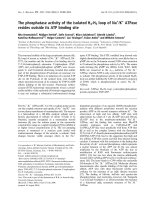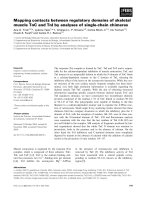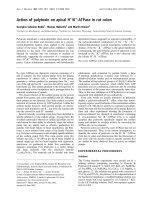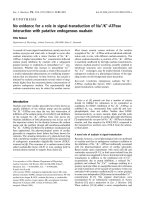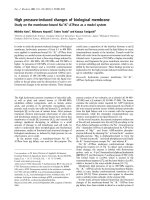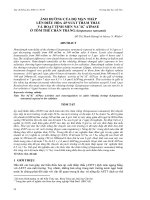Na+, k+ ATPase in single skeletal muscle fibres and the effects of ageing, training and inactivity
Bạn đang xem bản rút gọn của tài liệu. Xem và tải ngay bản đầy đủ của tài liệu tại đây (2.21 MB, 188 trang )
Na+, K+-ATPase in single skeletal muscle fibres and the effects of
ageing, training and inactivity
Submitted by
Victoria L. Wyckelsma
B. Appl Sci. (Hons)
April 2014
A thesis submitted in fulfilment of the requirements of the degree
Doctor of Philosophy
Supervisor: Professor Michael J. McKenna
Co-supervisors: Dr. Aaron Petersen
Dr. Itamar Levinger
Dr. Cedric Lamboley
Muscle Ions and Exercise Research Group
Institute of Sport, Exercise and Active Living
College of Sport and Exercise Science
Victoria University, Melbourne, Australia
I
ABSTRACT
The Na+,K+-ATPase (NKA) is a key protein involved in the maintenance of skeletal muscle
excitability and comprises 2 subunits (α and β), each of which express multiple isoforms at a
protein level in skeletal muscle (α1-3 and β1-3). The fibre-specific expression, adaptability and
roles of each isoform in human skeletal muscle are explored in this thesis. Research utilising
muscle biopsies typically uses samples obtained from the vastus lateralis muscle, which in
healthy young people comprises similar proportions of type I and II fibres. Analyses using
whole muscle pieces don’t allow the detection of fibre-type specific differences and changes
occurring at a cellular level. Hence analysis of skeletal muscle samples at the single fibre
level offers important advantages in understanding NKA regulation. This thesis therefore
investigated the isoform abundance of the NKA in human skeletal muscle single fibres and
their adaptability following intense repeated-sprint exercise (RSE) training in healthy young
adults (Study 1); with ageing (Study 2) and after high-intensity interval training (HIT) in the
elderly (Study 3) and after voluntary inactivity and resistance training in healthy young adults
(Study 4).
Study 1. The NKA plays a key role in muscle excitability, but little is known in human
skeletal muscle about possible fibre-type specific differences in NKA isoform expression or
adaptability. Hence a vastus lateralis muscle biopsy was taken in 17 healthy young adults and
the NKA isoform protein relative abundance contrasted between type I and II fibres. The
muscle fibre-type specific NKA adaptability in eight of these adults was then investigated
following four weeks of repeated-sprint exercise (RSE) training, comprising three sets of
5x4-s sprints, three days/week. Single fibres were separated and myosin heavy chain (MHC I,
MHC II) and NKA (α1-3 and β1-3) isoform abundance were determined via western blotting.
All six NKA isoforms were found to be expressed in both type I and II muscle fibres;
II
however, only the β2 NKA isoform exhibited fibre-type specific differences in abundance.
RSE training increased the β1 in type I fibres only (Pre-Train 0.58±0.28, Post-Train
0.76±0.38 a.u., 30%, p<0.05), but no training effects were found for other NKA isoforms in
either type I or II fibres. Thus human skeletal muscle does not express NKA isoforms in a
fibre-type specific manner and co-expression of all six NKA isoforms points to their different
functional roles in skeletal muscle cells. The detection of elevated NKA β1 abundance in type
I fibres following training, may have implications for increasing NKA activity during
intensive exercise, but needs further investigation. Finally, the fibre-type specific
upregulation of β1 demonstrates the sensitivity of the single fibre western blotting technique
for detecting fibre-type specific training effects.
Study 2. Ageing is associated with a reduction in muscle function and exercise performance,
which may be attributed in part to alterations in isoform composition of the NKA and may
include fibre type specific alterations. Therefore, 17 healthy older adults (69.4 ± 3.5 years,
170.8 ± 10.4 cm 75.2 ± 13.0 kg and 8.2 ± 4.4 hours of physical activity per week) and 14
younger adults (25.5 ± 2.8 years, 173.1 ± 12.3 cm, 72.9 ± 15.6 kg, 7.0 ± 3.9 hours of physical
activity per week) underwent a resting muscle biopsy for measurement of NKA isoforms in
single fibres and in a whole muscle homogenate (western blotting), as well as NKA content
([3H]ouabain binding site content). Compared to young, older adults had 17 % lower α3 NKA
isoform abundance in type II fibres (1.17 ± 0.72 vs. 0.97 ± 0.79 a.u, p < 0.05), 41% lower β2
isoform abundance in type I fibres (1.15±0.47 vs. 0.67±0.50, p < 0.05) and β3 increased in
type I fibres (p<0.05) There was a tendency for β2 to be decreased in type II fibres (p=0.09)
compared to young. No differences were detected in whole muscle homogenate for any of the
isoforms, except for β3, which conversely to single fibre analysis was decreased. The NKA
content did not differ between young and old (341±59.8 vs. 362±57.5 pmol.g-1 wet weight).
The NKA isoform expression differed with age in both type I and II fibres, with lower α3 and
III
β2 in the elderly. This study showed that older adults matched for physical activity to healthy
young adults had no differences in the relative abundance of key NKA α1, α2 and β1 isoforms
or in NKA content. It is possible that physical activity may be more important to NKA
content and not age per se. However, older adults did have decreases in the relative
abundance of α3 and β2 isoforms compared to young and the decline in these isoforms may
play a role in decreasing muscle NKA activity.
Study 3. Healthy young adults typically show increased skeletal muscle NKA content in
response to exercise training, which usually coincides with improved exercise performance.
Whether this is true in older adults and the NKA isoform abundance changes at the single
fibre level are also unknown. Fifteen older adults (study 3) were randomised into either a
control (CON, n=7) or training group (HIT, n=8) which underwent 12 weeks of highintensity interval training (4x4 min at 90-95% peak heart rate) for 3 days /wk. Participants
underwent a resting muscle biopsy prior to (Pre) and 48-72 hr following the final training
session (Post) for measurement of NKA isoforms in single fibres and in a whole muscle
homogenate (western blotting) and NKA content ([3H]ouabain binding site content). An
incremental cycling exercise test was also completed before and after training. In HIT, both
VO2 peak (18%) and peak power (25%) were improved following training (p<0.05), with no
changes in CON. In single fibres, after HIT, the NKA α2 isoform relative abundance was
increased by 30% in type II fibres (Pre 0.69 ± 0.25 vs. Post 0.90 ± 0.40 a.u, p <0.05) β2
abundance was increased by 52% in type I fibres (Pre 0.75±1.14 vs. Post 1.14±0.65 a.u ,
p<0.05) and β3 isoform was decreased by 48% in type I fibres (Pre 1.44±1.10 vs. Post
0.74±0.44 a.u, p<0.05). Whole muscle analyses showed no change in α2 or β2 isoform
abundance after HIT. The mitochondrial protein COX IV measured in whole muscle
homogenate was increased by 19% after HIT (p<0.05). The NKA content tended to be higher
after HIT (Pre 369.8 ± 52.7 vs. Post 403.0 ± 66.0, pmol.g wet weight-1, p<0.07), with no
IV
change in CON. This short volume, high-intensity training protocol was effective in
improving fitness in the elderly, increased muscle mitochondrial proteins and tended to
increase skeletal muscle NKA content. Furthermore, the use of whole muscle homogenate
was unable to detect changes in NKA isoforms after HIT that were evident on a cellular level,
indicating the single fibre technique should be utilized to detect potential training effects.
Study 4. Physical inactivity contributes to the development of numerous diseases, poor
muscle function and health. Induced inactivity via unilateral lower limb suspension (ULLS)
has detrimental effects on skeletal muscle fibre size, strength and function. The effects of
ULLS on skeletal muscle NKA, which is important to membrane excitability, is unknown.
Therefore this study investigated the effects of 23 days of ULLS on NKA isoform abundance
in single muscle fibres from six healthy sedentary adults (4 males, 2 females; age: 22.4± 2.1
yr, mass: 71.3 ± 14.3 kg, height: 175.0 ± 11.7 cm, BMI: 23.2 ± 3.6 kg.m-2, V̇O2 peak 45.5 ±
5.8 ml.kg-1.min-1, mean ± SD). Participants walked on crutches for 23 days, wearing a shoe
on their right foot with an enlarged sole (10 cm), thus enabling the left leg to hang freely and
be unloaded. Participants subsequently underwent 4 weeks of resistance training (RT).
Muscle biopsies were collected from the left vastus lateralis muscle before (CON) and after
ULLS (ULLS) and after RT and single fibres were collected and analysed. Compared to pre,
23 days of ULLS decreased α3 abundance in type I fibres (CON 1.70 ± 0.68, ULLS 1.26 ±
0.88 a.u, p<0.05) and this was not restored by RT (ULLS 1.26±0.88, RT 1.09±0.26 a.u).
There was a tendency for α1 (p<0.09) and β2 (p<0.06) to be increased in type I fibres
following ULLS. Surprisingly, the NKA isoforms α1, α2 and β1 were not different following
ULLS. Thus, short-term unloading via ULLS induced fibre-type specific adaptability of the
NKA isoforms, including a decreased α3 and tendency to increase α1 and β2 abundance in
type I fibres. The lack of a negative effect of unloading on most NKA isoforms was
surprising and a longer duration of ULLS may be required to see more dramatic changes. The
V
functional effect of the increase α1 and β2 isoforms may be to increase NKA activity, but this
remains to be determined. Furthermore, 4 weeks of RT was unable to restore the α3 isoform
and it is likely the decrease of α3 was too severe to be returned to baseline from only four
weeks of training.
In conclusion, this thesis has shown the co-expression of all six NKA isoforms within a
human single skeletal muscle fibre and this was shown in both type I and II fibres.
Additionally, the fibre-type specific adaptability of these isoforms in human skeletal muscle
was demonstrated following both RSE training and unloading in healthy young adults, as
well as fibre-type adaptability of the NKA in ageing and following HIT. Further, this thesis
shows that after HIT, an increase of α2 isoform relative abundance in type II fibres coincided
with a tendency of greater [3H]ouabain binding in older adults.
The interventions used in this thesis resulted in different outcomes for the NKA isoforms
within both type I and II fibres. The key NKA isoforms in skeletal muscle (α1, α2 and β1)
were hardly affected or not affected at all by RSE training, ULLS, ageing or HIT in the
elderly. The functional effects of these differences in NKA isoform expression and
adaptability on NKA activity and skeletal muscle excitability are a direction for future
research.
VI
DECLARATION
I, Victoria Louise Wyckelsma, declare that the PhD thesis entitled Na+, K+-ATPase in single
skeletal muscle fibres and the effects of ageing, training and inactivity is no more than
100,000 words in length, exclusive of tables, figures, appendices, references and footnotes.
This thesis contains no material that has been submitted previously, in whole part, for the
award of any other academic degree or diploma. Except where otherwise indicated this PhD
is my own work.
Signature
Date
VII
ACKNOWLEDGEMENTS
This thesis would not have been possible to put together if it weren’t for the help of many
others. This part is at least an attempt to acknowledge and thank those people.
To my principal supervisor Prof. Mike McKenna, thanks for taking me on as a PhD student
during a very busy time for you. Thanks for upholding me to the highest standard of research
at all times and for continuously pushing me to be better. For the encouragement to go
beyond out of my comfort zone and peruse an area of research that I thought could not have
been possible is something I will be forever grateful for. Thankyou for your honesty and
patience, and lastly for your friendship and ability to calm me in down when during very
stressful times. I’ve enjoyed working without through honours and now PhD and look
forward to future collaborations.
To my co-supervisors Dr. Aaron Petersen, Dr. Itamar Levinger and Dr. Cedric Lamboley.
Thankyou for your help on data collection days, guidance, timely feedback, honesty and
openness in all sorts of issues. Particular thanks to Itamar for the exceptional help, patience
and mentoring with the testing and training of the older adults especially with adverse events
and to Aaron for always being available to help whenever needed.
To Associate Professor Robyn Murphy, there is no probably no words to express all the
gratitude for the help you’ve given me during this thesis. You have gone truly well and
beyond the collaborative role you agreed to when I started my thesis. Thank you for firstly
teaching me in the ins and outs of westerns, for all the time spent looking at data with me, for
always having confidence in me, the constant encouragement and for inspiring me to become
a better scientist. Your mentoring in all sorts of matters, guidance and friendship has been
instrumental in this thesis being completed to the standard it has been.
VIII
Dr. Fabio Serpiello thankyou for the donation of muscle for the RSE study. Also thankyou
for the times when collecting data for this study, for showing me how to combine fun and
professionalism in the exercise physiology laboratory on trial days and for the initial help in
the biochemistry lab with overview of western blotting and basic lab skills.
To Mr. Ben Perry, thankyou for sharing a small portion of the ULLS muscle which we know
you worked tirelessly to obtain. Thankyou for teaching the [3H]ouabain content binding site
assay and for help with statistics. It’s been nothing but fun since we started undergrad and
lived at the student village together back in 2006. The general help, discussion and friendship
you provided during the course of this thesis has been highly valued and appreciated.
To my favourite lab managers Brad Gatt and Jess Meliak. Thanks for being there for
countless lab bookings, taking weekend and early morning phone calls when equipment
wasn’t working, always making time to teach me to use and set up equipment and for always
being available to have a listen and give out advice.
To the students and staff at VU in particular Chris, Ben, Jackson, Tania, Cian, Shelley,
Lauren, Matt and Adam. I could not ask for a better bunch of people to write a thesis with.
Also to the entire muscle cell biochemistry research group at La Trobe University, thanks for
making me part of the team. I’ve had some incredibly fun times with you guys and look
forward to more in the future. Particular thanks to Heidy for all the time she spent teaching
me everything in the lab from western blotting, sample preparation, trouble shooting,
answering the most ridiculous questions and for running gels for me when I was stuck for
time.
Dr. Mitchell Anderson, thank you for all the help including performing the muscle biopsies
and being so accommodating to the testing schedule. Also thankyou for always being on call
to provide advice and reassurance during the data collection.
IX
To all the participants throughout the four interventions in this thesis, thankyou so much for
your contribution, without you this PhD would have been impossible and also to the masters
and undergraduate students of the Clinical Exercise Science degree for help during testing
and primarily training of the older adults.
To my family, particularly Dad, Ben and Natalie thankyou for all the support, kind words and
encouragement throughout this time. Thanks for your patience and tolerance. Everything you
have done has made writing this thesis much easier.
Last but not least I need to thank my friends, a very large thankyou Felicity Kane and
Anthony Denaro in particular for the last 6 months of this thesis finishing for adopting me in
to their house, reminding me to eat, sleep and exercise on a daily basis. And to the rest of all
my amazing friends’ thanks for all the constant support, listening to me complain and for
getting me out of the house to have the occasional bit of fun and relaxation, but for also
understanding when study came first.
X
ABBREVIATIONS
[]
Concentration
Ca2+
Calcium ion
K+
Potassium ion
[K+]
Potassium ion concentration
[K+]a
Arterial potassium ion concentration
[K+]I
Interstitial potassium ion concentration
Na+
Sodium ion
[Na+]
Sodium ion concentration
[Na+]I
Interstitial sodium ion concentration
Mg2+
Magnesium ion
[3H]ouabain binding
Tritiated-ouabain binding
α
Alpha
β
Beta
µg
Microgram
µl
Microlitre
ADP
Adenosine diphosphate
AP
Action potential
ATP
Adenosine 5´ triphosphate
BMI
Body mass index
CaMKII
Ca2+ calmodulin-dependent protein kinase
cAMP
Adenosine 3´,5´-cyclic monophosphate
CGRP
Calcitonin gene related peptides
CO2
Carbon dioxide
COX IV
Cytochrome c oxidase/ complex IV
DHPR
dihydropyridine receptor
DVT
Deep vein thrombosis
EDL
Extensor digitorum longus muscle
Em
Membrane potential
FXYD1/PLM
Phospholemman
FXYD5
FXYD-domain containing ion transport regulator 5
GAPDH
Glyceraldehyde-3-phosphate dehydrogenase
XI
HIT
High-intensity training
IGF-1
Insulin growth factor-1
kDa
Kilodalton
kg/m2
Kilogram per meter squared
MCT1
Monocarboxylate transporter 1
MCT4
Monocarboxylate transporter 4
MHC
Myosin heavy chain
mRNA
Messenger ribonucleic acid
Na+, K+-ATPase/NKA
Sodium, potassium adenosine 5´triphosphatase
Na-EGTA
Sodium-ethylene glycol tetraacetic acid
PGC1-α
Peroxisome proliferator-activated receptor gamma
coactivated
PKA
Protein kinase A
PKC
Protein kinase C
pmol.g-1
picomoles per gram
RG
Red gastrocnemius muscle
RPE
Rating of perceived exertion
RPM
Revolutions per minute
RSE
Repeated-sprint exercise
RyR
Ryanodine receptor
SCI
Spinal cord injury
SDS
Solubilising buffer
SOL
Soleus muscle
SR
Sarcoplasmic reticulum
t-tubules
Transverse tubules
ULLS
Unilateral lower limb suspension
VO2 max
Maximum oxygen uptake
VO2 peak
Peak oxygen uptake
W.min-1
Watts per minute
WG
White gastrocnemius muscle
wk
Week
XII
PUBLICATIONS AND PRESENTATIONS
This thesis is supported by the following conference presentations and publications
Publications
1. Wyckelsma VL, McKenna MJ, Serpiello FR, Lamboley CR, Aughey RJ, Stepto NK,
Bishop DJ, Murphy RM. Single fibre co-expression and fibre-specific adaptability to
short-term intense exercise training of Na+, K+-ATPase α and β isoforms in human
skeletal muscle. Journal of Applied Physiology, Submitted April 2014.
Presentations
1. Wyckelsma VL, Levinger I, Petersen AC, Perry BD, Atanasovska T, Farr T,
McKenna, MJ. K+ dynamics in older adults during incremental exercise and recovery.
Oral presentation, MyoNaK (skeletal muscle and cardiac sodium- potassium pump
meeting) Beitostolen, Norway, 2012
2. Wyckelsma VL, Murphy RM, Serpiello FR, Lamboley CR, McKenna MJ. Repeatedsprint exercise training up-regulates the β1 isoform of the Na+-K+-ATPase in both type
I and IIa fibres in human skeletal muscle fibres. Oral Presentation. European College
of Sport Sciences (ECSS) Conference. Barcelona, Spain, June 2013
3. Wyckelsma VL, Murphy RM, Serpiello FR, Lamboley CR, McKenna MJ. Fibre-type
specific differences and adaptability of the Na+, K+-ATPase α1-3 and β1-3 isoforms to
intermittent training in human single skeletal muscle fibres. Poster Presentation.
International Union Physiological Society (IuPS) Meeting. Birmingham, United
Kingdom, July 2013.
XIII
4. Wyckelsma VL, Murphy RM, Levinger I, Petersen AC, McKenna MJ. The effects of
high-intensity interval training on aerobic power and skeletal muscle Na+, K+-ATPase
in single fibres of healthy older adults. Oral Presentation. Australian Society of
Medical Research (ASMR) National Conference. Ballarat, Australia, Nov 2013.
5. Wyckelsma VL, Murphy RM, Levinger I, Petersen AC, McKenna MJ. Highintensity interval training in older adults does not upregulate the Na+, K+-ATPase
isoforms measured in whole muscle homogenate, but shows fibre type specific
upregulation when analysed on the single fibre level. Oral Presentation. Australian
Physiological Society (AuPS) National Conference. Geelong, Australia, Dec 2013
XIV
TABLE OF CONTENTS
ABSTRACT............................................................................................................................... I
DECLARATION .....................................................................................................................VI
ACKNOWLEDGEMENTS ................................................................................................... VII
ABBREVIATIONS .................................................................................................................. X
PUBLICATIONS AND PRESENTATIONS ........................................................................ XII
TABLE OF CONTENTS ...................................................................................................... XIV
LIST OF TABLES ................................................................................................................ XXI
LIST OF FIGURES ........................................................................................................... XXIII
CHAPTER 1. INTRODUCTION ............................................................................................ 25
CHAPTER 2- Literature Review ............................................................................................. 30
2.1 Overview of skeletal muscle structure ........................................................................... 30
2.1.1 Basic overview of excitation-contraction coupling .................................................... 31
2.1.2 Skeletal muscle excitability ........................................................................................ 31
2.2 Skeletal Muscle Na+,K+-ATPase ................................................................................... 34
2.2.1 Function and structure................................................................................................. 34
2.2.2 Quantification of the NKA in human skeletal muscle ................................................ 36
2.2.2.1 [3H]ouabain binding ............................................................................................. 36
2.2.2.2 Western blotting ................................................................................................... 37
2.2.3 Fibre-type specificity of the NKA isoforms in skeletal muscle .................................. 40
2.2.3.1 Alpha isoform fibre-type specificity .................................................................... 40
2.2.3.2 Beta isoform fibre type specificity....................................................................... 40
2.2.3.3 FXYD1 fibre-type specificity .............................................................................. 41
2.2.4 Intracellular localisation of NKA isoforms in skeletal muscle ................................... 41
2.2.5 Specific functions of NKA isoforms........................................................................... 42
XV
2.2.6 NKA acute regulation ................................................................................................. 43
2.2.6.1 Intracellular Na+ ................................................................................................... 44
2.2.6.2 Phosphorylation of FXYD1 ................................................................................. 45
2.2.7 Chronic adaptability of skeletal muscle NKA ............................................................ 46
2.2.7.1 Hormonal regulation ................................................................................................ 46
2.2.7.2 Thyroid hormone ................................................................................................. 46
2.2.7.3 Growth Hormone ................................................................................................. 46
2.2.7.4 Corticosteroids ..................................................................................................... 46
2.2.7.5 K+ depletion and supplementation ....................................................................... 47
2.3 Exercise training overview ............................................................................................ 48
2.3.1 Training and skeletal muscle NKA ............................................................................. 49
2.3.2 Exercise Training and PLM ........................................................................................ 55
2.4 Inactivity ........................................................................................................................ 55
2.4.1 Introduction to unilateral lower leg suspension model ............................................... 56
2.4.2 Functional and structural effects on skeletal muscle following ULLS ....................... 57
2.4.3 Molecular adaptations to skeletal muscle NKA following inactivity ......................... 57
2.5 Ageing, skeletal muscle NKA adaptability and exercise training ................................. 58
2.5.1 Exercise performance in the elderly ........................................................................... 58
2.5.2 Skeletal muscle adaptations to ageing ........................................................................ 59
2.5.3 Skeletal muscle NKA content in age .......................................................................... 59
2.5.4 Adaptations of NKA isoforms to ageing .................................................................... 60
2.5.5 Isoform adaptations to exercise training in aged rats.................................................. 64
2.5.6 Muscle [3H]ouabain changes following exercise training in the elderly .................... 64
2.5.7 High-intensity exercise and training in the elderly ..................................................... 64
2.6 AIMS.............................................................................................................................. 66
2.6.1 Study One.................................................................................................................... 66
2.6.2 Study Two ................................................................................................................... 66
XVI
2.6.3 Study Three ................................................................................................................. 66
2.7 HYPOTHESES .............................................................................................................. 67
2.7.1 Study One.................................................................................................................... 67
2.7.2 Study Two ................................................................................................................... 67
2.7.3 Study Three ................................................................................................................. 67
2.7.4 Study Four ................................................................................................................... 67
CHAPTER 3. Single fibre co-expression and fibre-specific adaptability to short-term
intense exercise training of Na+, K+-ATPase α and β isoforms in human skeletal muscle . 69
3.1 INTRODUCTION ......................................................................................................... 69
3.2 METHODS .................................................................................................................... 72
3.2.1 Participants and overview ....................................................................................... 72
3.3.2 Repeat-Sprint Training............................................................................................ 72
3.3.3 Muscle biopsy sampling and fibre separation ......................................................... 73
3.2.4 Single muscle fibre western blotting....................................................................... 73
3.2.4.1 Western blot data analysis ................................................................................... 76
3.2.5 Alpha 2 antibody validation .................................................................................... 78
Statistical Analysis ........................................................................................................... 78
3.3 RESULTS ...................................................................................................................... 80
3.3.1 Co-expression and fibre-type specificity of NKA isoforms in single fibres .......... 80
3.3.2 Fibre-type specific adaptability to RSE training..................................................... 83
3.3.3 Antibody testing ...................................................................................................... 83
3.4 DISCUSSION ................................................................................................................ 86
3.4.1 Homogenous expression of the α isoforms in type I and II fibres in human skeletal
muscle .............................................................................................................................. 86
3.4.2 Fibre-specific expression of the beta isoforms in type I and II fibres .................... 88
3.4.3 Effects of RSE training on NKA isoforms ............................................................. 90
3.5 Conclusions .................................................................................................................... 91
XVII
CHAPTER 4. The impacts of ageing on single fibre Na+, K+-ATPase isoform fibre type
content and whole muscle [3H]ouabain binding site content ............................................... 93
4.1 INTRODUCTION ......................................................................................................... 93
4.2 METHODS .................................................................................................................... 95
4.2.1 Participants .............................................................................................................. 95
4.2.2 Experimental design................................................................................................ 95
4.2.3 Familiarisation ........................................................................................................ 96
4.2.4 Symptom limited incremental test (VO2 peak) ....................................................... 96
4.2.5 Resting muscle biopsy and single fibre separation ................................................. 97
4.2.6 Whole muscle homogenate ..................................................................................... 97
4.2.7 Western blotting ...................................................................................................... 98
4.2.7.1 Data normalisation ............................................................................................. 100
4.2.7.1.1 Single fibres .................................................................................................... 100
4.2.7.1.2 Whole muscle homogenate ............................................................................. 100
4.2.8 [3H]ouabain binding site content .......................................................................... 100
4.2.9 Statistical Analysis ................................................................................................ 101
4.3 RESULTS .................................................................................................................... 102
4.3.1 Participant exclusion ............................................................................................. 102
4.3.2 Incremental exercise test performance.................................................................. 102
4.3.3 Effects of ageing on NKA isoform abundance in single fibres ............................ 102
4.3.3 NKA isoform abundance in whole muscle homogenate in old and young........... 104
4.3.4 Effects of ageing and GAPDH fibre-type specificity in human single fibres and
whole muscle ................................................................................................................. 107
4.3.5 [3H]ouabain binding .............................................................................................. 108
............................................................................................................................................ 109
4.4 DISCUSSION .............................................................................................................. 110
4.4.1 Implications of changes of NKA isoform abundance in single fibres of older adults
........................................................................................................................................ 110
XVIII
4.4.2 No decreases in [3H]ouabain binding in ageing .................................................... 112
4.4.3 Methodological considerations - Single fibre and whole muscle homogenate
western blotting in ageing .............................................................................................. 113
4.5 CONCLUSIONS.......................................................................................................... 115
CHAPTER 5 The effect of high-intensity interval training in older adults on Na+, K+ATPase isoform abundance in single fibres and [3H]ouabain binding site content ........... 117
5.1 INTRODUCTION ....................................................................................................... 117
5.2 METHODS .................................................................................................................. 119
5.2.1 Participants ............................................................................................................ 119
5.2.2 Experimental design.............................................................................................. 119
5.2.3 Familiarisation ...................................................................................................... 119
5.2.4 Signs and symptom limited graded incremental test ............................................ 120
5.2.5 Training and control groups .................................................................................. 120
5.2.6 Resting muscle biopsy and single fibre separation ............................................... 121
5.2.7 Whole muscle homogenate preparation ................................................................ 121
5.2.8 Western Blots ........................................................................................................ 121
5.2.8.1 Western blotting analysis ................................................................................... 122
5.2.9 [3H]ouabain binding site content .......................................................................... 122
5.2.10 Statistical Analysis .............................................................................................. 122
5.3 RESULTS .................................................................................................................... 123
5.3.1 Physical Characteristics of older adults training vs. control at baseline ............... 123
5.3.2 Compliance to training and adverse responses occurring from HIT .................... 123
5.3.3 The effects of HIT on body mass, VO2 peak and exercise performance .............. 123
5.3.4 Isoform abundance in single fibres following HIT ............................................... 123
5.3.5 Isoform abundance in whole muscle pre-post training ......................................... 124
5.3.6 [3H]ouabain binding .............................................................................................. 124
5.4 DISCUSSION .............................................................................................................. 129
5.4.1 NKA isoform and whole muscle changes with HIT in the elderly ....................... 129
XIX
5.4.2 Enhanced VO2 peak and exercise performance following HIT ............................ 132
5.5 CONCLUSIONS.......................................................................................................... 133
CHAPTER 6 The effects of 23 days of unilateral lower limb suspension (ULLS) on Na+,
K+-ATPase isoform abundance in single skeletal muscle fibres from healthy young adults
............................................................................................................................................ 134
6.1 INTRODUCTION ....................................................................................................... 134
6.2 METHODS .................................................................................................................. 136
6.2.2 Participants ............................................................................................................ 136
6.2.3 Inactivity protocol ................................................................................................. 136
6.2.4 Re-training protocol .............................................................................................. 137
6.2.5 Muscle biopsy, single fibre dissection and western blotting procedures .............. 137
6.2.5.1 Normalisation of single fibres ............................................................................ 137
6.2.6 Statistical Analysis ................................................................................................ 139
6.3 RESULTS .................................................................................................................... 140
6.3.1 Adaptation of the NKA isoforms to ULLS and following resistance training. .... 140
6.4 DISCUSSION .............................................................................................................. 144
6.4.1 Efficacy of ULLS in loss of muscle strength and mass ........................................ 144
6.4.2 ULLS and subsequent resistance training differentially affect NKA isoforms .... 144
6.4.3 Comparisons to and limitations in previous studies ............................................. 147
6.4.4 Limitations in the current study ............................................................................ 147
6.5 CONCLUSIONS.......................................................................................................... 149
CHAPTER 7 GENERAL DISCUSSIONS, CONCLUSIONS AND DIRECTION FOR
FUTURE RESEARCH .......................................................................................................... 150
7.1 GENERAL DISCUSSION .......................................................................................... 150
7.1.1 The expression of the skeletal muscle NKA isoforms in single muscle fibres ..... 150
7.1.2 Adaptability of the NKA isoforms measured in single muscle fibres .................. 158
7.1.3 Major NKA isoforms and [3H]ouabain binding site content are unchanged in
ageing ............................................................................................................................. 160
XX
7.3 CONCLUSIONS.......................................................................................................... 163
7.3.1 Study One.................................................................................................................. 163
2.3.2 Study Two ................................................................................................................. 163
7.3.3 Study Three ............................................................................................................... 163
7.3.4 Study Four ................................................................................................................. 164
7.4 FUTURE RESEARCH DIRECTION.......................................................................... 164
REFERENCES ...................................................................................................................... 168
XXI
LIST OF TABLES
Table 1.1 Basic functions of the NKA isoforms in skeletal muscle…………………………25
Table 2.1 [3H]ouabain binding site content in healthy young adults………………………...39
Table 2.2 Factors which stimulate skeletal muscle Na+, K+-ATPase activity……………… 44
Table 2.3 Exercise performance and skeletal muscle Na+, K+-ATPase adaptations to exercise
training in healthy young humans……………………………………………………………51
Table 2.4 Skeletal muscle Na+, K+-ATPase isoform abundance changes with ageing in
rats……………………………………………………………………………………………62
Table 3.1 Primary antibodies used to detect Na+, K+-ATPase and Myosin Heavy Chain
isoforms……………………………………………………………………………………. 75
Table 3.2 Na+, K+-ATPase isoform abundance in type I and II fibres of healthy young
humans……………………………………………………………………………………… 82
Table 4.1 Primary antibodies used for Na+, K+-ATPase, Myosin Heavy Chain and GAPDH
analysis………………………………………………………………………………………99
Table 4.2 Na+, K+-ATPase isoform abundance in type I and II fibres from biopsies collected
from healthy young and old adults………………………………………………………….103
Table 4.3 Whole muscle homogenate for Na+, K+-ATPase isoforms using three different
normalisation methods……………………………………………………………………...106
Table 5.1 Physical characteristics and performance measures of healthy older adults before
and after 12 weeks of high-intensity interval training or control…………………………...125
Table 5.2 Na+, K+-ATPase isoform abundance in type I and II fibres before and after 12
weeks of high-intensity interval training in the elderly…………………………………….126
Table 6.1 Number of fibres and participants in type I fibres for each Na+, K+-ATPase isoform
before, after 23 days of unilateral lower limb suspension and following 4 weeks of resistance
training……………………………………………………………………………………..142
Table 6.2 Number of fibres and participants in type II fibres for each Na+, K+-ATPase
isoform before, after 23 days of unilateral lower limb suspension and following 4 weeks of
resistance training………………………………………………………………………….142
XXII
Table 7.1 Comparison of findings using two statistical approaches to assess Na+, K+-ATPase
α1 isoform abundance in type I and II fibres in healthy young people, in samples collected at
baseline prior to each intervention in each study…………………………………………...151
Table 7.2 Comparison of findings using two statistical approaches to assess Na+, K+-ATPase
α2 isoform abundance in type I and II fibres in healthy young people, in samples collected at
baseline prior to each intervention in each study…………………………………………...151
Table 7.3 Comparison of findings using two statistical approaches to assess Na+, K+-ATPase
β1 isoform abundance in type I and II fibres in healthy young people, in samples collected at
baseline prior to each intervention in each study…………………………………………...152
Table 7.4 Comparison of findings using two statistical approaches to assess Na+, K+-ATPase
β3 isoform abundance in type I and II fibres in healthy young people, in samples collected at
baseline prior to each intervention in each study…………………………………………...152
Table 7.5 Comparison of findings using two statistical approaches to assess Na+, K+-ATPase
α3 isoform abundance in type I and II fibres in healthy young people, in samples collected at
baseline prior to each intervention in each study…………………………………………...154
Table 7.6 Comparison of findings using two statistical approaches to assess Na+, K+-ATPase
β2 isoform abundance in type I and II fibres in healthy young people, in samples collected at
baseline prior to each intervention in each study…………………………………………...154
XXIII
LIST OF FIGURES
Figure 2.1 Molecular structure of the Na+, K+-ATPase……………………………………..35
Figure 2.2 Unilateral lower limb suspension………………………………………………...56
Figure 3.1 Representative blot of Na+, K+-ATPase isoforms in single human skeletal muscle
fibres…………………………………………………………………………………………81
Figure 3.2 Na+, K+-ATPase isoforms in type I and II fibres before and after RSE training..84
Figure 3.3 Representative blot of α2 validation……………………………………………..85
Figure 4.1 GAPDH in whole muscle in old and young…………………………………....104
Figure 4.2 The relative abundance of GAPDH in type I and II fibres from young and old
adults……………………………………………………………………………………… 107
Figure 4.3 The raw data (density) for total protein and GAPDH measured in whole muscle
homogenate from healthy young and older adults ……………………………………….. 108
Figure 4.4 [3H]ouabain binding content in old and young ………………………………. 109
Figure 4.5 [3H]ouabain binding site content in and 65-69 years (open bars), 70-76 years
(pattern bars) and young (closed bars)……………………………………………………..109
Figure 5.1 Skeletal muscle [3H]ouabain binding site content before and following 12 weeks
of high-intensity interval training…………………………………………………………. 127
Figure 5.2 Skeletal muscle [3H]ouabain from older adults who completed HIT separated into
responders and non-responders……………………………………………………………..128
Figure 6.1 Example of a three point calibration curve for the Na+, K+-ATPase β1 isoform 138
Figure 6.2 Representative blots of Na+, K+-ATPase at baseline, following ULLS and
following four weeks of resistance training………………………………………………...141
Figure 6.3 Na+, K+-ATPase isoforms in type I and II fibres before, following 23 days of
ULLS and 4 weeks of resistance training…………………………………………………..143
Figure 7.1 Representative blot of skeletal muscle fibres for fibre-typing using myosin heavy
chain I and II antibodies…………………………………………………………………….166
Figure 7.2 The same representative blot of skeletal muscle fibres for fibre-typing using
myosin heavy chain I and II antibodies in addition to the alpha-actinin 3 antibody……….167
25
CHAPTER 1. INTRODUCTION
Muscle contraction requires the repeated propagation of action potentials (AP) along and into
the muscle cells, which is dependent on the cell membrane potential and excitability, which
are regulated by intracellular and extracellular concentration gradients and conductance of
K+, Na+ and Cl- ions (Hodgkin & Horowicz, 1959; Pedersen et al., 2005). During muscle
contractions, increased AP frequency result in a greater exchange of Na+ and K+ ions across
the cell membrane and may impair excitability (Sjøgaard et al., 1985; Sejersted & Sjǿgaard,
2000). The skeletal muscle Na+, K+-ATPase (NKA) enzyme counteracts the excitationinduced Na+ and K+ fluxes and thus is important in maintaining excitability and contraction.
Consequently, any modulation of muscle NKA, either acutely or chronically, has the
potential to affect muscle function. In muscle the NKA content is measured using the
[3H]ouabain binding site content assay, with NKA isoform expression measured by western
blotting, typically in whole homogenates or in muscle extracts. In skeletal muscle, six
isoforms (α1-3, β1-3) of the NKA are expressed. The basic function of each isoform is listed
below in Table 1.1.
Table 1.1 Basic functions of the NKA isoforms in skeletal muscle
NKA
Function
isoform
α1
Key housekeeping isoform, large contribution to Na+/K+ exchange mainly
during basal conditions
α2
Key α isoform in skeletal muscle, comprises approximately ~80% of the α
subunits. Major function is to Na+/K+ exchange during muscle contractions
